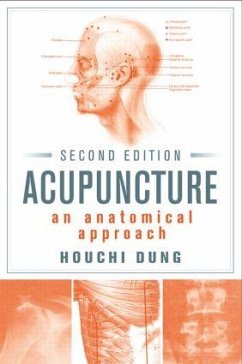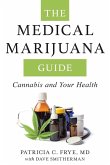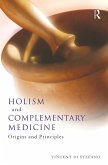- Gebundenes Buch
- Merkliste
- Auf die Merkliste
- Bewerten Bewerten
- Teilen
- Produkt teilen
- Produkterinnerung
- Produkterinnerung
Practiced for more than 2,000 years, acupuncture was once restricted to the realm of alternative medicine. This book dispels these notions and brings this once backroom therapy into the forefront-explaining it in terms that can be easily comprehended by all medical professionals. Presenting a scientific, anatomical approach to acupuncture, it discusses the basics of the nervous system, acupuncture points throughout the body, and measurement and quantification of pain. It reviews applications of acupuncture in clinical practice, from cases easy to treat to those more challenging, and concludes with theories on the future of acupuncture.…mehr
Andere Kunden interessierten sich auch für
![The Medical Marijuana Guide The Medical Marijuana Guide]() Dave SmithermanThe Medical Marijuana Guide17,99 €
Dave SmithermanThe Medical Marijuana Guide17,99 €![Holism and Complementary Medicine Holism and Complementary Medicine]() Vincent Di StefanoHolism and Complementary Medicine170,99 €
Vincent Di StefanoHolism and Complementary Medicine170,99 €![Chris Shelton's Easy Guide to Fix Neck and Back Pain Chris Shelton's Easy Guide to Fix Neck and Back Pain]() Chris SheltonChris Shelton's Easy Guide to Fix Neck and Back Pain29,99 €
Chris SheltonChris Shelton's Easy Guide to Fix Neck and Back Pain29,99 €![New England Botanic Medical and Surgical Journal; 2, (1848) New England Botanic Medical and Surgical Journal; 2, (1848)]() Calvin NewtonNew England Botanic Medical and Surgical Journal; 2, (1848)40,99 €
Calvin NewtonNew England Botanic Medical and Surgical Journal; 2, (1848)40,99 €![Nature's Best Remedies: Top Medicinal Herbs, Spices, and Foods for Health and Well-Being Nature's Best Remedies: Top Medicinal Herbs, Spices, and Foods for Health and Well-Being]() National GeographicNature's Best Remedies: Top Medicinal Herbs, Spices, and Foods for Health and Well-Being30,99 €
National GeographicNature's Best Remedies: Top Medicinal Herbs, Spices, and Foods for Health and Well-Being30,99 €![Supplement to the American Dispensatory Supplement to the American Dispensatory]() John KingSupplement to the American Dispensatory36,99 €
John KingSupplement to the American Dispensatory36,99 €![Handbook of Herbal Medicine Handbook of Herbal Medicine]() Handbook of Herbal Medicine152,99 €
Handbook of Herbal Medicine152,99 €-
-
-
Practiced for more than 2,000 years, acupuncture was once restricted to the realm of alternative medicine. This book dispels these notions and brings this once backroom therapy into the forefront-explaining it in terms that can be easily comprehended by all medical professionals. Presenting a scientific, anatomical approach to acupuncture, it discusses the basics of the nervous system, acupuncture points throughout the body, and measurement and quantification of pain. It reviews applications of acupuncture in clinical practice, from cases easy to treat to those more challenging, and concludes with theories on the future of acupuncture.
Hinweis: Dieser Artikel kann nur an eine deutsche Lieferadresse ausgeliefert werden.
Hinweis: Dieser Artikel kann nur an eine deutsche Lieferadresse ausgeliefert werden.
Produktdetails
- Produktdetails
- Verlag: Taylor & Francis
- 2nd edition
- Seitenzahl: 256
- Erscheinungstermin: 24. Oktober 2013
- Englisch
- Abmessung: 254mm x 183mm x 20mm
- Gewicht: 635g
- ISBN-13: 9781466581920
- ISBN-10: 1466581921
- Artikelnr.: 38080668
- Herstellerkennzeichnung
- Libri GmbH
- Europaallee 1
- 36244 Bad Hersfeld
- gpsr@libri.de
- Verlag: Taylor & Francis
- 2nd edition
- Seitenzahl: 256
- Erscheinungstermin: 24. Oktober 2013
- Englisch
- Abmessung: 254mm x 183mm x 20mm
- Gewicht: 635g
- ISBN-13: 9781466581920
- ISBN-10: 1466581921
- Artikelnr.: 38080668
- Herstellerkennzeichnung
- Libri GmbH
- Europaallee 1
- 36244 Bad Hersfeld
- gpsr@libri.de
Houchi Dung earned a Ph.D. in anatomy from the University of Louisville in 1970. Soon after, he accepted a faculty position in the Department of Anatomy, School of Medicine, at the University of Texas Health Science Center at San Antonio, which he held until his retirement in 2002. His main responsibilities were teaching gross human anatomy to medical and dental students and conducting research on a number of neurological mutations in mice. During his 31-year academic career, he published 24 papers on the field of acupuncture from his clinical experience. He has published several books on acupuncture and pain-three in English and three in Chinese.
Introduction. Anatomy in Acupuncture. General Consideration. Identity of
Acupoints. All in the Sensory Nerves. Efferent Fibers. Afferent Fibers.
Muscular Nerve Branches. Cutaneous Nerve Branches. Anatomical Features
Contributing to the Formation of Acupoints. Acupoints of the Cranial
Nerves. Cranial Nerves Without Acupoints. Cranial Nerves with Acupoints.
Trigeminal Nerve. Facial Nerve. Glossopharyngeal Nerve. Vagus Nerve. Spinal
Accessory Nerve. Acupoints in the Neck Region. Boundaries of the Neck.
Formation of the Cervical Plexus. Acupoints of the Cutaneous Branches.
Acupoints of Muscular Branches. Acupoints in the Upper Limb. Topography of
the Upper Limb. Organization of the Brachial Plexus. Acupoints on the
Pectoral Region. Acupoints Over the Scapular Region. Arm and Forearm. Wrist
and Hand. Acupoints in the Body Trunk. Defining a Typical Spinal Nerve.
Composition of Fibers in the Typical Spinal Nerves. Distributions of
Acupoints. Acupoints On Back Of The Neck. Acupoints on the Dorsal Surface
of the Chest. Acupoints on the Lumbar and Sacrum. Acupoints in the Front.
Lateral Side of the Chest Cage. Acupoints in the Lower Limb. Regional
Anatomy. Lumbar Plexus. Sacral Plexus. Acupoints of the Lumbar Plexus.
Acupoints of the Sacral Plexus. Distributions to the Thigh. Distributions
in the Popliteal Fossa. Acupoints on the Posterior Compartment of the Leg
and Ankle. Acupoints on the Lateral Compartment of the Leg. Acupoints on
the Anterior Compartment of the Leg. Acupoints on the Foot. Physiology in
Acupuncture. Electrical Phenomena of the Body. Electrical Activity in
Acupoints. Dynamic Nature of Acupoints. Three Phases of Acupoints. Physical
Properties of Acupoints. Biochemistry in Acupuncture. Biochemistry in
Relation to Acupuncture. Terminologies in Neurotransmitters. Relevance of
Neurotransmitters. Importance of Endorphin. Other Neurotransmitters.
Immediate Acupuncture Reactions. Reactions After Acupuncture. Pathology in
Acupuncture. Conventional Wisdom in Pathology. Pathological Origins.
Endogenous Origins. Exogenous Origins. Modes for Trigger Points to Appear.
Combination of Systemic and Regional Appearances. A Special Case.
Psychology in Acupuncture. Psychology of Pain. True or False. Historical
Prospect of Pain Perception. Mental Attitude Toward Pain. The Vicious Cycle
of Pain. Rebutting Acupuncture as Placebo. Pain and Measurement. A
Challenge and A Puzzle. Measurements of Pain. Subjective Pain Versus
Objective Pain. Ranking the Trigger Points. Trigger Points in Four Groups.
Trigger Points on the Spinous Processes. Results of Pain Measurement. Acute
Versus Chronic Pain. Good to Excellent Applications. General Guidelines.
Samples of Pain for Demonstration. Defining Good to Excellent Results. Pain
in the Face and Head. Pain in the Neck and Shoulders. Pain in the Upper
Limbs. Pain in the Body Trunk. Pain in the Lower Limbs. Applications with
Mixed and Limited Results. Defining Mixed and Limited. Irrelevant to Pain.
Subjective Pain Perceived. Pain in the Face and Head. Pain in the Neck and
Shoulder. Pain in the Upper Limb. Pain in the Body Trunk. Pain in the Lower
Limb. Diffuse Pain. Difficult Patients with Poor Results. Connecting
Difficult and Poor. Profiles of Difficult Patients. Pain in the Face and
Head. Difficult Pain from the Neck to the Fingers. Pain After Surgery.
Phantom Limb Pain. Spondylitic Abnormalities. Reflex Sympathetic Dystrophy.
Tailbone Fracture. Difficult Patients with Different Results. Index.
Acupoints. All in the Sensory Nerves. Efferent Fibers. Afferent Fibers.
Muscular Nerve Branches. Cutaneous Nerve Branches. Anatomical Features
Contributing to the Formation of Acupoints. Acupoints of the Cranial
Nerves. Cranial Nerves Without Acupoints. Cranial Nerves with Acupoints.
Trigeminal Nerve. Facial Nerve. Glossopharyngeal Nerve. Vagus Nerve. Spinal
Accessory Nerve. Acupoints in the Neck Region. Boundaries of the Neck.
Formation of the Cervical Plexus. Acupoints of the Cutaneous Branches.
Acupoints of Muscular Branches. Acupoints in the Upper Limb. Topography of
the Upper Limb. Organization of the Brachial Plexus. Acupoints on the
Pectoral Region. Acupoints Over the Scapular Region. Arm and Forearm. Wrist
and Hand. Acupoints in the Body Trunk. Defining a Typical Spinal Nerve.
Composition of Fibers in the Typical Spinal Nerves. Distributions of
Acupoints. Acupoints On Back Of The Neck. Acupoints on the Dorsal Surface
of the Chest. Acupoints on the Lumbar and Sacrum. Acupoints in the Front.
Lateral Side of the Chest Cage. Acupoints in the Lower Limb. Regional
Anatomy. Lumbar Plexus. Sacral Plexus. Acupoints of the Lumbar Plexus.
Acupoints of the Sacral Plexus. Distributions to the Thigh. Distributions
in the Popliteal Fossa. Acupoints on the Posterior Compartment of the Leg
and Ankle. Acupoints on the Lateral Compartment of the Leg. Acupoints on
the Anterior Compartment of the Leg. Acupoints on the Foot. Physiology in
Acupuncture. Electrical Phenomena of the Body. Electrical Activity in
Acupoints. Dynamic Nature of Acupoints. Three Phases of Acupoints. Physical
Properties of Acupoints. Biochemistry in Acupuncture. Biochemistry in
Relation to Acupuncture. Terminologies in Neurotransmitters. Relevance of
Neurotransmitters. Importance of Endorphin. Other Neurotransmitters.
Immediate Acupuncture Reactions. Reactions After Acupuncture. Pathology in
Acupuncture. Conventional Wisdom in Pathology. Pathological Origins.
Endogenous Origins. Exogenous Origins. Modes for Trigger Points to Appear.
Combination of Systemic and Regional Appearances. A Special Case.
Psychology in Acupuncture. Psychology of Pain. True or False. Historical
Prospect of Pain Perception. Mental Attitude Toward Pain. The Vicious Cycle
of Pain. Rebutting Acupuncture as Placebo. Pain and Measurement. A
Challenge and A Puzzle. Measurements of Pain. Subjective Pain Versus
Objective Pain. Ranking the Trigger Points. Trigger Points in Four Groups.
Trigger Points on the Spinous Processes. Results of Pain Measurement. Acute
Versus Chronic Pain. Good to Excellent Applications. General Guidelines.
Samples of Pain for Demonstration. Defining Good to Excellent Results. Pain
in the Face and Head. Pain in the Neck and Shoulders. Pain in the Upper
Limbs. Pain in the Body Trunk. Pain in the Lower Limbs. Applications with
Mixed and Limited Results. Defining Mixed and Limited. Irrelevant to Pain.
Subjective Pain Perceived. Pain in the Face and Head. Pain in the Neck and
Shoulder. Pain in the Upper Limb. Pain in the Body Trunk. Pain in the Lower
Limb. Diffuse Pain. Difficult Patients with Poor Results. Connecting
Difficult and Poor. Profiles of Difficult Patients. Pain in the Face and
Head. Difficult Pain from the Neck to the Fingers. Pain After Surgery.
Phantom Limb Pain. Spondylitic Abnormalities. Reflex Sympathetic Dystrophy.
Tailbone Fracture. Difficult Patients with Different Results. Index.
Introduction. Anatomy in Acupuncture. General Consideration. Identity of
Acupoints. All in the Sensory Nerves. Efferent Fibers. Afferent Fibers.
Muscular Nerve Branches. Cutaneous Nerve Branches. Anatomical Features
Contributing to the Formation of Acupoints. Acupoints of the Cranial
Nerves. Cranial Nerves Without Acupoints. Cranial Nerves with Acupoints.
Trigeminal Nerve. Facial Nerve. Glossopharyngeal Nerve. Vagus Nerve. Spinal
Accessory Nerve. Acupoints in the Neck Region. Boundaries of the Neck.
Formation of the Cervical Plexus. Acupoints of the Cutaneous Branches.
Acupoints of Muscular Branches. Acupoints in the Upper Limb. Topography of
the Upper Limb. Organization of the Brachial Plexus. Acupoints on the
Pectoral Region. Acupoints Over the Scapular Region. Arm and Forearm. Wrist
and Hand. Acupoints in the Body Trunk. Defining a Typical Spinal Nerve.
Composition of Fibers in the Typical Spinal Nerves. Distributions of
Acupoints. Acupoints On Back Of The Neck. Acupoints on the Dorsal Surface
of the Chest. Acupoints on the Lumbar and Sacrum. Acupoints in the Front.
Lateral Side of the Chest Cage. Acupoints in the Lower Limb. Regional
Anatomy. Lumbar Plexus. Sacral Plexus. Acupoints of the Lumbar Plexus.
Acupoints of the Sacral Plexus. Distributions to the Thigh. Distributions
in the Popliteal Fossa. Acupoints on the Posterior Compartment of the Leg
and Ankle. Acupoints on the Lateral Compartment of the Leg. Acupoints on
the Anterior Compartment of the Leg. Acupoints on the Foot. Physiology in
Acupuncture. Electrical Phenomena of the Body. Electrical Activity in
Acupoints. Dynamic Nature of Acupoints. Three Phases of Acupoints. Physical
Properties of Acupoints. Biochemistry in Acupuncture. Biochemistry in
Relation to Acupuncture. Terminologies in Neurotransmitters. Relevance of
Neurotransmitters. Importance of Endorphin. Other Neurotransmitters.
Immediate Acupuncture Reactions. Reactions After Acupuncture. Pathology in
Acupuncture. Conventional Wisdom in Pathology. Pathological Origins.
Endogenous Origins. Exogenous Origins. Modes for Trigger Points to Appear.
Combination of Systemic and Regional Appearances. A Special Case.
Psychology in Acupuncture. Psychology of Pain. True or False. Historical
Prospect of Pain Perception. Mental Attitude Toward Pain. The Vicious Cycle
of Pain. Rebutting Acupuncture as Placebo. Pain and Measurement. A
Challenge and A Puzzle. Measurements of Pain. Subjective Pain Versus
Objective Pain. Ranking the Trigger Points. Trigger Points in Four Groups.
Trigger Points on the Spinous Processes. Results of Pain Measurement. Acute
Versus Chronic Pain. Good to Excellent Applications. General Guidelines.
Samples of Pain for Demonstration. Defining Good to Excellent Results. Pain
in the Face and Head. Pain in the Neck and Shoulders. Pain in the Upper
Limbs. Pain in the Body Trunk. Pain in the Lower Limbs. Applications with
Mixed and Limited Results. Defining Mixed and Limited. Irrelevant to Pain.
Subjective Pain Perceived. Pain in the Face and Head. Pain in the Neck and
Shoulder. Pain in the Upper Limb. Pain in the Body Trunk. Pain in the Lower
Limb. Diffuse Pain. Difficult Patients with Poor Results. Connecting
Difficult and Poor. Profiles of Difficult Patients. Pain in the Face and
Head. Difficult Pain from the Neck to the Fingers. Pain After Surgery.
Phantom Limb Pain. Spondylitic Abnormalities. Reflex Sympathetic Dystrophy.
Tailbone Fracture. Difficult Patients with Different Results. Index.
Acupoints. All in the Sensory Nerves. Efferent Fibers. Afferent Fibers.
Muscular Nerve Branches. Cutaneous Nerve Branches. Anatomical Features
Contributing to the Formation of Acupoints. Acupoints of the Cranial
Nerves. Cranial Nerves Without Acupoints. Cranial Nerves with Acupoints.
Trigeminal Nerve. Facial Nerve. Glossopharyngeal Nerve. Vagus Nerve. Spinal
Accessory Nerve. Acupoints in the Neck Region. Boundaries of the Neck.
Formation of the Cervical Plexus. Acupoints of the Cutaneous Branches.
Acupoints of Muscular Branches. Acupoints in the Upper Limb. Topography of
the Upper Limb. Organization of the Brachial Plexus. Acupoints on the
Pectoral Region. Acupoints Over the Scapular Region. Arm and Forearm. Wrist
and Hand. Acupoints in the Body Trunk. Defining a Typical Spinal Nerve.
Composition of Fibers in the Typical Spinal Nerves. Distributions of
Acupoints. Acupoints On Back Of The Neck. Acupoints on the Dorsal Surface
of the Chest. Acupoints on the Lumbar and Sacrum. Acupoints in the Front.
Lateral Side of the Chest Cage. Acupoints in the Lower Limb. Regional
Anatomy. Lumbar Plexus. Sacral Plexus. Acupoints of the Lumbar Plexus.
Acupoints of the Sacral Plexus. Distributions to the Thigh. Distributions
in the Popliteal Fossa. Acupoints on the Posterior Compartment of the Leg
and Ankle. Acupoints on the Lateral Compartment of the Leg. Acupoints on
the Anterior Compartment of the Leg. Acupoints on the Foot. Physiology in
Acupuncture. Electrical Phenomena of the Body. Electrical Activity in
Acupoints. Dynamic Nature of Acupoints. Three Phases of Acupoints. Physical
Properties of Acupoints. Biochemistry in Acupuncture. Biochemistry in
Relation to Acupuncture. Terminologies in Neurotransmitters. Relevance of
Neurotransmitters. Importance of Endorphin. Other Neurotransmitters.
Immediate Acupuncture Reactions. Reactions After Acupuncture. Pathology in
Acupuncture. Conventional Wisdom in Pathology. Pathological Origins.
Endogenous Origins. Exogenous Origins. Modes for Trigger Points to Appear.
Combination of Systemic and Regional Appearances. A Special Case.
Psychology in Acupuncture. Psychology of Pain. True or False. Historical
Prospect of Pain Perception. Mental Attitude Toward Pain. The Vicious Cycle
of Pain. Rebutting Acupuncture as Placebo. Pain and Measurement. A
Challenge and A Puzzle. Measurements of Pain. Subjective Pain Versus
Objective Pain. Ranking the Trigger Points. Trigger Points in Four Groups.
Trigger Points on the Spinous Processes. Results of Pain Measurement. Acute
Versus Chronic Pain. Good to Excellent Applications. General Guidelines.
Samples of Pain for Demonstration. Defining Good to Excellent Results. Pain
in the Face and Head. Pain in the Neck and Shoulders. Pain in the Upper
Limbs. Pain in the Body Trunk. Pain in the Lower Limbs. Applications with
Mixed and Limited Results. Defining Mixed and Limited. Irrelevant to Pain.
Subjective Pain Perceived. Pain in the Face and Head. Pain in the Neck and
Shoulder. Pain in the Upper Limb. Pain in the Body Trunk. Pain in the Lower
Limb. Diffuse Pain. Difficult Patients with Poor Results. Connecting
Difficult and Poor. Profiles of Difficult Patients. Pain in the Face and
Head. Difficult Pain from the Neck to the Fingers. Pain After Surgery.
Phantom Limb Pain. Spondylitic Abnormalities. Reflex Sympathetic Dystrophy.
Tailbone Fracture. Difficult Patients with Different Results. Index.








